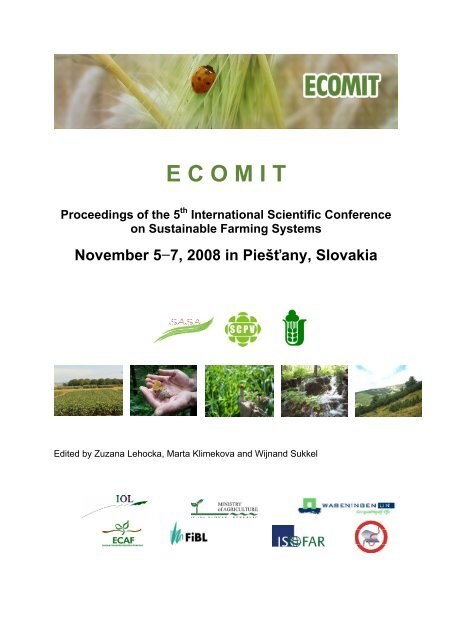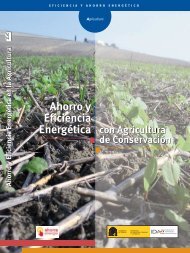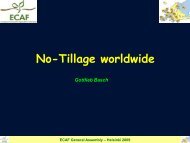E C O M I T - European Conservation Agriculture Federation-ECAF
E C O M I T - European Conservation Agriculture Federation-ECAF
E C O M I T - European Conservation Agriculture Federation-ECAF
You also want an ePaper? Increase the reach of your titles
YUMPU automatically turns print PDFs into web optimized ePapers that Google loves.
E C O M I TthProceedings of the 5 International Scientific Conferenceon Sustainable Farming SystemsNovember 5−7, 2008 in Piešťany, SlovakiaEdited by Zuzana Lehocka, Marta Klimekova and Wijnand Sukkel
The contents of the articles published in this proceeding are the responsibility of theauthors. The text in its original form is without a stylistic revision.ECOMIT – Proceedings of the Fifth International Scientific conference on sustainablefarming systems, 5-7 November 2008 in Piešťany, Slovakia. Slovak Association forSustainable <strong>Agriculture</strong>, Slovak Agricultural Research Centre – Research Institute ofPlant Production Piešťany in cooperation with Wageningen University and ResearchCentre the Netherlands, International Society of Organic <strong>Agriculture</strong> Research(ISOFAR), <strong>European</strong> <strong>Conservation</strong> <strong>Agriculture</strong> <strong>Federation</strong> (<strong>ECAF</strong>), Institute ofOrganic <strong>Agriculture</strong> (IOL), Research Institute of Organic <strong>Agriculture</strong> (FIBL), SlovakNo–till club (SNTC), Ministry of <strong>Agriculture</strong> of the Slovak Republic.1 st EditionPiešťany, 2008ISBN: 978-80-969603-1-6© 2008, Slovak Association for Sustainable <strong>Agriculture</strong>, c/o Slovak AgriculturalResearch Centre – Research Institute of Plant Production PiešťanyLayout: Zuzana Lehocka and Jarmila PoništováLayout technical support: Kios, s.r.o.Printed by: 3xK, SlovakiaDistribution: Paper copies may be ordered from the Slovak Association forSustainable <strong>Agriculture</strong>, Považany 124, 916 26 Považany, Slovakia,zuska_l@inmail.sk
Table of contentsPreface .................................................................................................................................................5Dear Reader .........................................................................................................................................6Acknowledgements ............................................................................................................................7Plenary sessionFAO on climate change in the <strong>European</strong> Region.Sasse, V. ………………………………………………………………………………………..……………....9Organic and conservation agriculture, the best of both worlds?Sukkel, W. ……………………………………………………………………………………… …………….14<strong>Conservation</strong> agriculture: The sustainable response for soil conservation and other challengesfacing <strong>European</strong> <strong>Agriculture</strong>.Basch, G. .......................................................................................................................... ................17Sustainable soil cultivation strategies: Approaches in conventional and organic agriculture.Köpke, U. …………………………………………………………………………………………… …………24Scientific session I. A Soil cultivation systemsThe influence of different tillage systems on content and distribution of nutrients andorganic components in soil.Šoltysová B., Danilovič M. ………………………………………………………………………… … ……..33Hydrophysical properties of a clayey soil as affected by different tillage systems.Kotorová, D., Mati, R. ………………………………………………………………………………… ……..37Different soil tillage and fertilization and its influence on the spring barley yields.Danilovič, M., Šoltysová, B. ………………………………………………………………………… ……..42Mulching effect on weed suppression in organic vegetable cultivation.Kołosowski, S., Szafirowska, A. ……………………………………………………………………… ….....46Crop yield and response of soil quality indicators to no tillage practice in a loam degradedchernozem on loess in SlovakiaLehocká, Z. et al. ………………………………………………………………………………………………50Effect of different tillage systems on some soil physical properties of a loam degraded chernozem onloess in the Slovak Republic.Klimeková, M. et al. ……………………………………………………………………………………………55Scientific session I.B Soil management and soil qualityThe potential of no-till and residue management to sequester carbon under rainfed Meditterraneanconditions.Basch, G. et al. …………………………………………………………………………………………………61Organic fertilizers of the Mac trial and their impact on soil quality, environment and climate change.Koopmas, C.J. et al. …………………………………………………………………………………………...67Selected soil properties by different ratios of cereals in crop rotations and in continuous cropping.Babulicová, M., Sekerková, M. ……………………………………………………………………………….70Correlation of soil management and carbon stock change in soils.Zsembeli, J. et al. ………………………………………………………………………………………………75Scientific session I.C. Energy production and soil compactionSustainability, overall and process efficiency of energy crops.Schäfer, W. ……………………………………………………………………………………………………..82Dutch (organic) agriculture, carbon sequestration and energy production.Burgt, G.J. van der et al. ………………………………………………………………………………………88Effect of soil compaction on N 2 O emission from a sandy loam soil fertilized with mineral fertilizer orcattle slurry.Hansen, S. ………………………………………………………………………………………………………923
Potential of low ground pressure for harvesting machinery in a controlled traffic system in organicagriculture.Vermeulen, B., Sukkel., W. ……………………………………………………………………………………96Scientific session II.A Soil biology and biodiversityAn attempt to assess soil biodiversity in long term field experiments in Prague.Kubát, J. et al. …………………………………………………………………………………………………101Organic pest management – Benefits and Risks.Wyss, E. et al. …………………………………………………………………………………………………106Farm management plans in land use optimization and biodiversity protection.Šarapatka, B. et al. …………………………………………………………………………………………...113Selected biological and biochemical soil characteristics in organic and conventional farming.Sarapatka, B. et al. …………………………………………………………………………………………...118Scientific session II.B Soil pollution and water managementInfluence of pesticides on the microbial diversity in the cambisols.Hudecová, I., Javoreková, S. ………………………………………………………………………………..125Landscape area of dry polder Beša and its using.Kováč, L., Kotorová, D. ………………………………………………………………………………………132Transpiration regime and biomass production.Novák, V., Vidovič, J. ………………………………………………………………………………………...137Combined effect of drought and high atmospheric CO 2 concentration on cereals.Veisz, O. et al. ………………………………………………………………………………………………...146Scientific session II.C Soil conservation and policySoiln <strong>Conservation</strong> and policy measures – Findings from eight case studies across Europe.Prager, K. ……………………………………………………………………………………………………...151Policy measures encouraging soil conservation in agriculture – a case study from Brandenburg(Germany).Hagemann, N. et al. ………………………………………………………………………………………….157Salinisation in the case of Belozem village, Bulgaria. Matching technical and Policy measures.Penov, I. et al. …………………………………………………………………………………………………161Soil environmental functions – their societal importance and value.Bujnovský, R., Vilček, J. …………………………………………………………………………………......167PostersResearch on energy willow production in Hungary.Gyuricza, P. et al. …………………………………………………………………………………………….175Comparing the nematode community structure and soil characteristics of organic and conventionallymanaged leek on sandy soils.Buchan, D. et al. ………………………………………………………………………………………………177Ethylene biosynthesis in pea cultivated in vitro.Váňová, L. et al. ………………………………………………………………………………………………181Biodiversity of Pulse crops in Iran.Najib Nia, S. …………………………………………………………………………………………………..183Different soil type and tillage influence on selected herbicides breakdown.Tóth, Š. ………………………………………………………………………………………………………..185Quantification of rhizosphere microorganisms for bioindication of soil quality.Ködöböcz, L. et al. ……………………………………………………………………………………………191Effect of crop stands on the local earthworm population.Sivaruban, S. et al. …………………………………………………………………………………………...1934
The 5th International Scientific Conference on Sustainable Farming SystemsE C O M I TThe plot size of each treatment in the first trial on crop and residue management was15x 3m, using a randomized complete block design as experimental layout. Thesecond trial was a simple split of four strips (replications) into 3 treatments of differentamounts of residues of 3x3m each. Both trials were realized with four replications.The crops were installed with a Semeato direct drill, equipped with staggered doubledisc openers and repeated over 3 years on the same area in order to accumulate theeffect of the residues and their management.Sampling and analysisBefore crop installation in October 2004 all plots were subject to an initialassessment of SOC. According a fixed scheme, composite samples of 14 points perplot (15x3m) were taken for the crop and residue management trial. Due to thereduced dimension of the residue trial, 12 points per replication (11x3m, with 1 mbetween residue levels) were considered sufficient for the initial assessment of SOC.Samples were taken using a core sampler with a diameter of 5 centimetres to adepth of 20 centimetres. This depth limit was chosen because no considerable soildisruption through soil tillage would take place and thus no relevant changes of SOCwere expected below this depth. The cores were subdivided into three layers: 0-5cm,5-10cm and 10-20cm. At the end of the project period, in November 2007, anidentical sampling was performed in the case of the crop and residue managementtrial. In the residue trial, sampling was split up into the different residue levels using 8points per plot of residues. Samples were air dried, grinded and then analysed in anautomated combustion furnace working at 1350°C (Leco SC-144DR) using 3replicates per sample. Bulk densities were determined for each replication of the twotrials at the beginning of the project, but no significant differences between thelocations were detected. Average bulk densities were 1.52 and 1.55 for the layers 0-10cm and 10-20cm, respectively.Results and DiscussionDespite the relatively small area of implantation of the crop and residue managementtrial (40 x 45m), the initial sampling revealed considerable and even significantdifferences with regard to the levels of SOM. The spatial variability of soil propertiesand especially soil carbon on even small areas is well documented (Arnold andWilding, 1991; Wilding et al., 2001). Sampling, handling and analysis were carriedout with utmost care and individual values were checked for their consistency.Nonetheless, SOM levels in the monitored soil layer showed significant lower valuesin the straw and grazing treatments when compared to the chickpea treatment (table2). In 2007, only the treatment with the highest amount of residues (2 x straw)revealed a significantly higher level of SOM. Regarding the changes obtained inSOM within the 3 years’ trial period (table 2 and figure 1), both “straw” treatmentsshowed a considerable increase in SOM of almost 0.2%, which was significantlydifferent when compared to the other treatments. The chickpea crop with its lowamount of fast degrading residues showed even a slight decrease in SOM. Thedistribution of dry sheep manure showed a higher increase in SOM than the stubbletreatment, although not significantly different.63
The 5th International Scientific Conference on Sustainable Farming SystemsE C O M I Tlevels in the monitored soil layer was very similar to the one obtained in the crop andresidue management trial (figure 2). Straw removal and the maintenance of stubbleslightly increased the SOM content in the 20 cm top layer, whereas straw return andadditional amounts of straw, which could occur under improved soil fertility conditionsor irrigation, increased SOM up to 0.2% in the topsoil layer within a period of 3 years.Both trials reveal the potential of the combination of no-till as non soil disruptive formof crop establishment and the return or maintenance of slowly degradable cropresidues such as wheat straw for the increase of SOM on the highly organic carbondepleted Mediterranean soils. These findings are in accordance with resultspublished by other authors (Dick et al., 1998; Clapp et al., 2000; Layese et al., 2002;West and Post, 2002) that report an increase of carbon incorporated into SOM whenchanging from intensive tillage to no-till, but only if harvestable carbon residues likestraw or cornstalks were left in the field. However, contradictory results can be foundin the review performed by Wilhelm et al. (2004), indicating that residue return maylead or not to an accumulation of SOM. Sanchéz et al. (2002), measuring the CO 2flux from conventional and reduced tilled fields, found a reduction of 6660 kg CO 2ha -1 year -1 under reduced tillage. This amount of carbon dioxide corresponds toaround 3000 kg SOM ha -1 , which is approximately the yearly SOM increase found inthe most favourable treatments in the trials, assuming a bulk density of 1.5.0.4change in organic matter (%)0.30.20.10-0.1Stubble Straw 2 x StrawStraw residue levels0-5 cm5-10 cm10-20 cm0-20 cmFigure 2: Relative changes in soil organic matter with depth under three levels ofwheat straw residues after 3 years.The evaluation of the total amount of SOC sequestered after only three years ofdifferentiated treatments is certainly questionable. Nonetheless, the differencesbetween crop type and residue levels and their management are considerable andgive evidence of the potential contribution of the combined effect of no till and cropresidue return to the build-up of SOM even under conditions of relatively low biomassproduction of Mediterranean rainfed agriculture. They also confirm that high C/Nratios of the residues are essential for the incorporation of crop carbon into SOM.65
The 5th International Scientific Conference on Sustainable Farming SystemsE C O M I TAcknowledgementsThis paper has been produced within the project POCTI/AGG/46545/2002: Potentialof no-tillage for carbon sequestration on agricultural land, and has been possiblethanks to the financial support given by the <strong>European</strong> Union (FEDER) through theFoundation for Science and Technology (FCT).ReferencesArnold, R.W. and L.P. Wilding. 1991. The need to quantify spatial variability. P. 1-8.In: M.J. Mausbach and L.P. Wilding (eds.), Spatial Variability of Soils andLandforms. Soil Sci. Soc. Am. Spec. Publ. 28. Soil Sci. Soc. Am., Madison, WI.Clapp, C.E., R.R. Allmaras, M.F. Layese, D.R. Linden, and R.H. Dowdy. 2000. Soilorganic carbon and 13-C abundance as related to tillage, crop residue, andnitrogen fertilizer under continuous corn management in Minnesota. Soil TillageRes. 55:127–142.Dick, W.A., R.L. Blevins, W.W. Frye, S.E. Peters, D.R. Christenson, F.J. Pierce, andM.L. Vitosh. 1998. Impacts of agricultural management practices on C-sequestration in forest-derived soils of the eastern Corn Belt. Soil Tillage Res.47:235–244.Jarvis, P., A. Rey, C. Petsikos, L. Wingate, M. Rayment, J. Pereira, J. Banza, J.David, F. Miglietta, M. Borghetti, G. Manca, and R. Valentini. 2007. Drying andwetting of Mediterranean soils stimulates decomposition and carbon dioxideemission: the "Birch effect". Tree Physiology 27:929-940.Kay, B.D., and A.J. VandenBygaart. 2002. <strong>Conservation</strong> tillage and depthstratification of porosity and soil organic matter. Soil Tillage Res. 66:107-118.Layese, M.F., C.E. Clapp, R.R. Allmaras, D.R. Linden, S.M. Copeland, J.A.E. Molina,and R.H. Dowdy. 2002. Current and relic carbon using natural abundance carbon-13. Soil Sci. 167:315–326.Logsdon, S.D., T.C. Kaspar, and C.A. Cambardella. 1999. Depth-incremental soilproperties under no-till or chisel management. Soil Sci.Soc. Am. J. 63:197-200.Sanchez, M.L., M.I. Ozores, R. Colle, M.J. Lopez, B. De Torre, M.A. Garcia, and I.Perez. 2002. Soil CO 2 fluxes in cereal land use of the Spanish plateau: influenceof conventional and reduced tillage practices. Chemosphere 47:837-844.West, T.O., and W.M. Post. 2002. Soil organic carbon sequestration rates by tillageand crop rotation: A global data analysis. Soil Sci.Soc. Am. J. 66:1930–1946.Wilding L.P., L.R. Drees and L.C. Nordt. 2001. Spatial Variability: Enhancing theMean Estimate of Organic and Inorganic Carbon in a Sampling Unit. In: R. Lal,J.M. Kimble, R.F. Follett and B.A. Stewart (eds), Assessment Methods for SoilCarbon. CRC Press, Boca Raton, Fl., pp. 69-86.Wilhelm, W.W., J.M.F. Johnson, J.L. Hatfield, W.B. Voorhees, and D.R. Linden.2004. Crop and soil productivity response to corn residue removal: A literaturereview. Agronomy Journal 96:1-17.Zdruli, P., Jones, R.J.A. and Montanarella L.. 2004. Organic Matter in the Soils ofSouthern Europe. <strong>European</strong> Soil Bureau Research Report No. 15. Office forOfficial Publications of the <strong>European</strong> Communities, Luxembourg. EUR 21083 EN,17pp.66




